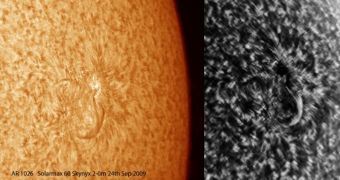For the first time in more than a year, the Sun's face is again spotted. Two new features have been identified on its surface, and astronomers say that this may be an indicator of the fact that the solar cycle is intensifying. Though it should theoretically be near the peak of the current cycle, the star has been very lazy for the past two years, showing off only minimal sunspots, and less activity than usual.
Large numbers of studies were conducted on the star over the past years, all aimed at understanding precisely why it experienced this hiatus in activity. At one point, astronomers said that it would again exhibit its full force in 2008, but that obviously didn't happen. Additionally, for the better part of 2009, things have remained the same, with only mild signs of a comeback being recorded this year.
According to official statistics, 80 percent of this year's days saw no sunspots developing on the star. While it's safe to say that fewer solar emissions were recorded because of it, astronomers started being more and more concerned about the situation, as weeks went past, and nothing happened, Wired reports. The amount of sunspot activity has been linked to the total amount of energy the Earth receives.
Some planetary scientists believe that, if the Sun was to experience a sudden rise in activity, then the ensuing emissions and solar flares could have a considerable influence on the planet's global climate patterns. Historic records show that this solar minimum has been the longest ever recorded, in more than a century. And its correlation with climate change has been extensively studied, experts say.
A big sunspot was recorded in May, bringing about hopes that the star's normal activity would return. However, this proved to be a singular occurrence, which did not repeat itself in the following days and weeks. The current minimum was, however, “not out of the extreme ordinary,” the former NASA chief sunspot watcher, Michael Kaiser, said earlier this year. Variations in activity have been recorded before, in the long line of solar cycles observed continuously.

 14 DAY TRIAL //
14 DAY TRIAL //